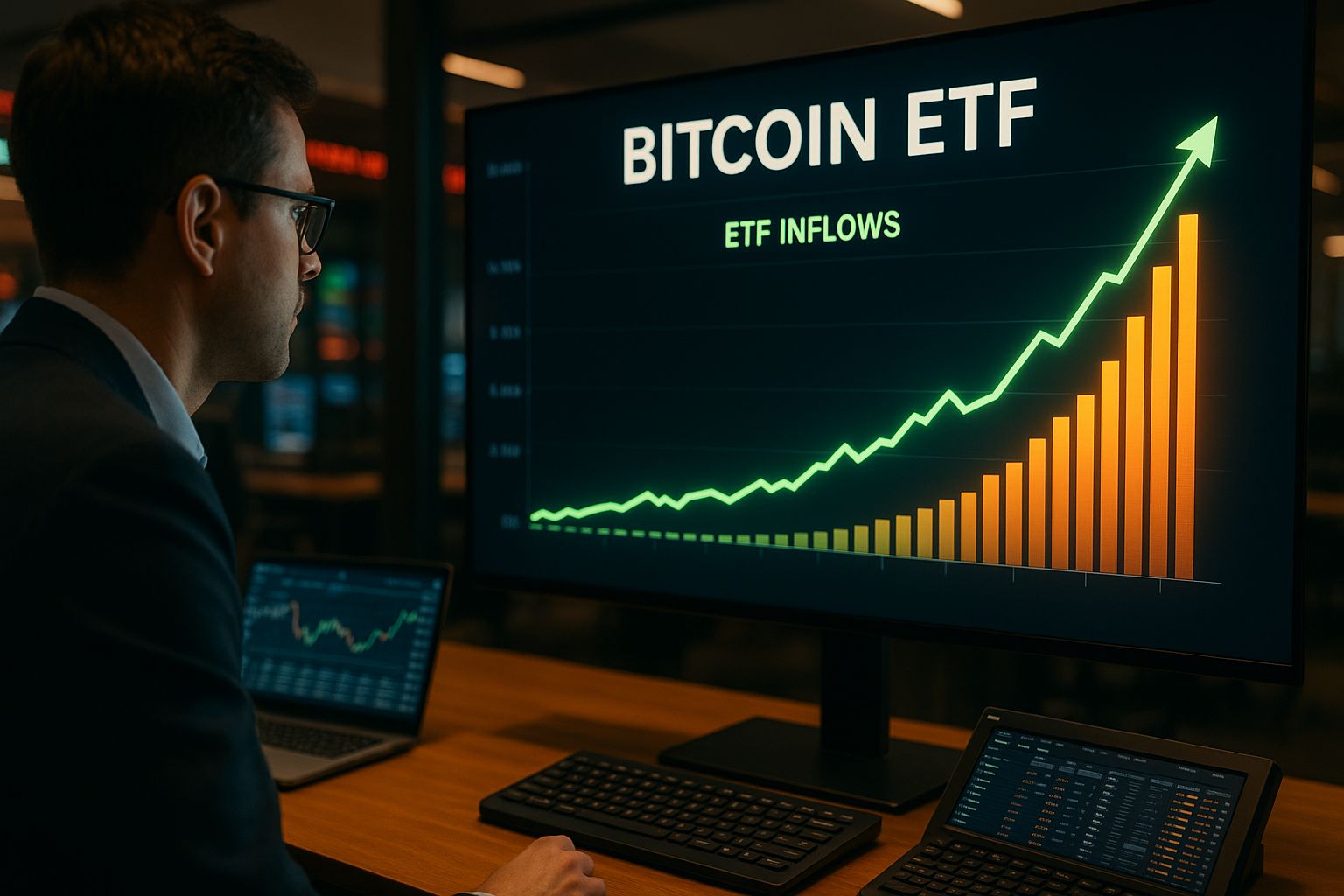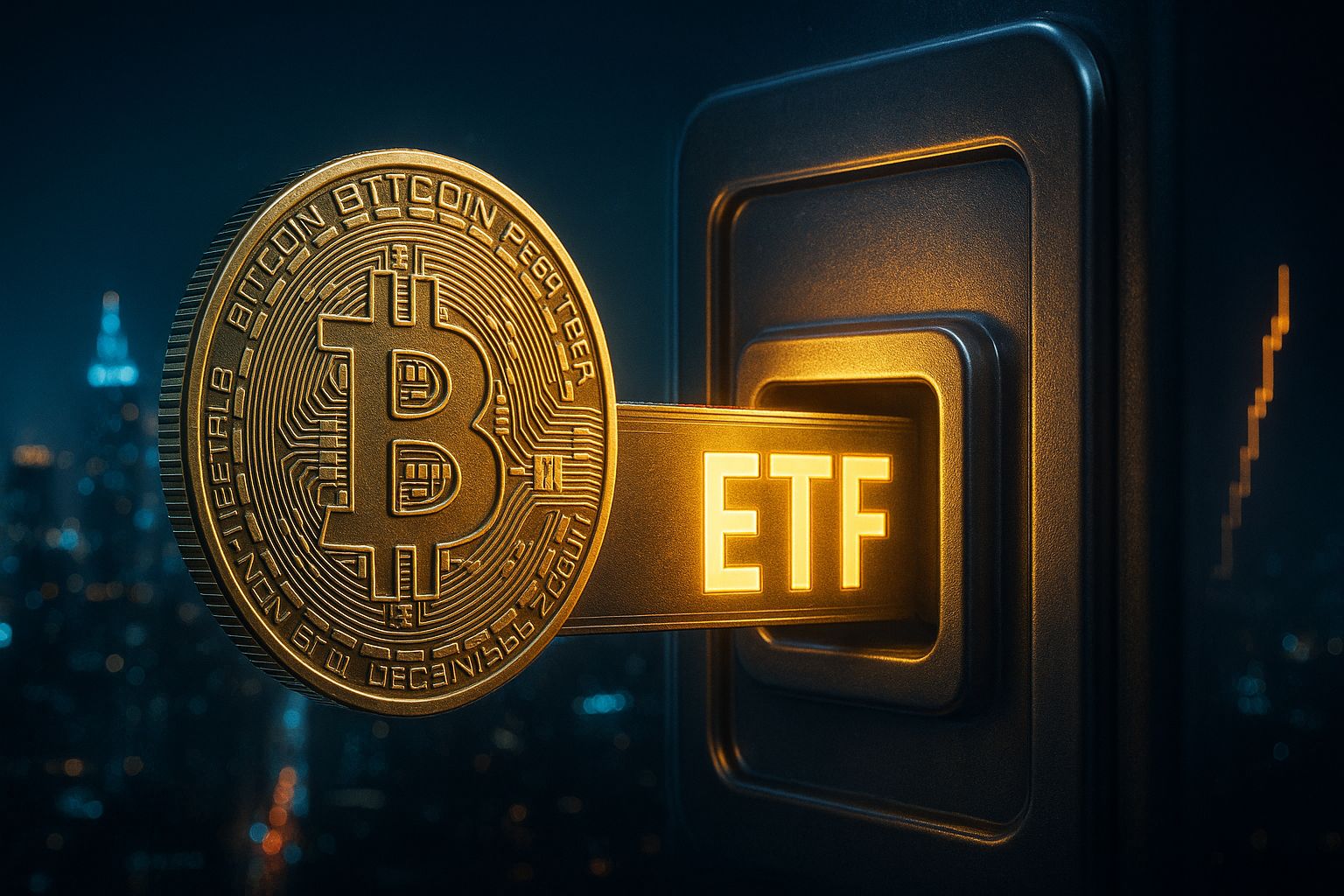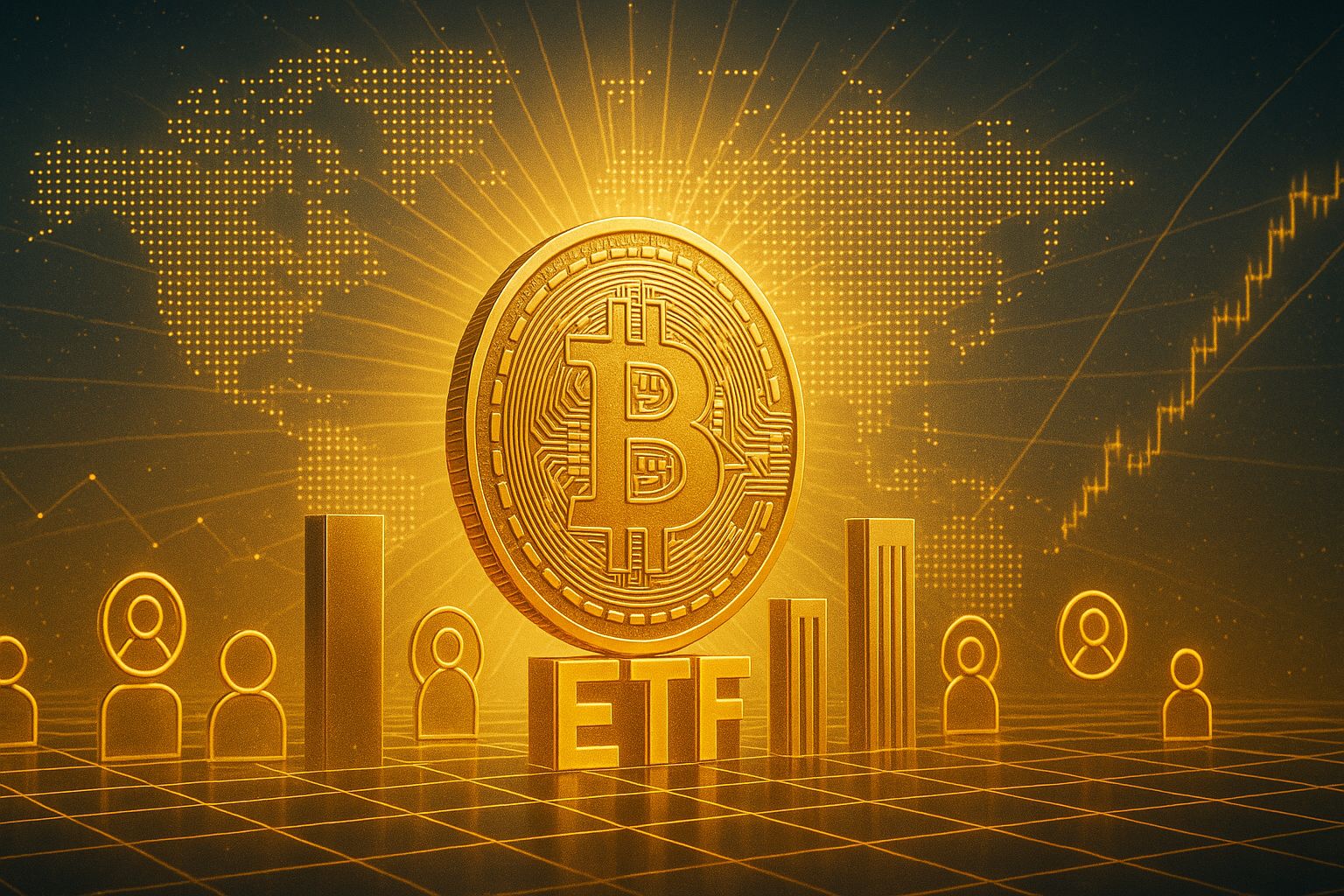- CROX ROAD
- Posts
- Global Bitcoin ETFs Attract Biggest Weekly Inflows Since July
Global Bitcoin ETFs Attract Biggest Weekly Inflows Since July
Global Bitcoin ETFs recorded their strongest weekly inflows since July, attracting over 20,000 BTC in new capital. Discover why institutional demand is rising, what it means for Bitcoin’s price, and how ETFs are shaping the future of crypto adoption.
Bitcoin exchange-traded funds (ETFs) around the world have just recorded their largest weekly inflows since July, marking a sharp return of institutional demand for the world’s leading cryptocurrency. According to recent data, over 20,000 BTC flowed into ETF-like products in a single week, sending a strong signal about renewed investor appetite despite broader market volatility.
This development is particularly important because ETFs bridge the gap between traditional finance and the digital asset ecosystem. They allow mainstream investors to access Bitcoin exposure through regulated, familiar structures without dealing with the complexities of wallets and private keys. The timing of these inflows also suggests that confidence is strengthening ahead of key macroeconomic and crypto-specific milestones.
With the crypto market constantly under the spotlight from regulators and global institutions, large ETF inflows provide a level of credibility that bolsters Bitcoin’s position in the broader financial system. They serve as a reminder that while retail sentiment may fluctuate, institutional interest continues to grow steadily in the background.
Table of Contents

The Numbers Behind the Surge
The week’s inflows totaled approximately 20,685 BTC, representing hundreds of millions of dollars in net new capital. This surge marks the strongest inflow activity in over two months, a period that previously saw more muted demand as investors grappled with macroeconomic uncertainties, interest rate hikes, and summer market slowdowns.
For comparison, Bitcoin ETFs had been experiencing uneven flows in the weeks prior, with some funds recording small outflows due to price corrections. This latest wave of inflows demonstrates renewed conviction from investors, signaling that they view current prices as attractive entry points. It also indicates that Bitcoin continues to serve as a hedge for those seeking diversification in times of financial uncertainty.
Looking ahead, if such inflows become a sustained trend, Bitcoin ETFs could potentially surpass their previous records for assets under management. This would place Bitcoin alongside gold and other traditional commodities as a serious investment vehicle for global portfolios, further strengthening its role as “digital gold.”
Why the Inflows Matter
Institutional Adoption Grows
ETFs provide traditional investors, pension funds, and asset managers with regulated access to Bitcoin without needing to directly hold the digital asset. A spike in inflows often reflects strong institutional positioning for the medium to long term. As more financial institutions allocate capital, the foundation of Bitcoin’s market becomes more resilient.
These inflows suggest that institutional adoption is not only continuing but accelerating, despite market challenges. When long-term investors allocate capital to Bitcoin ETFs, it adds legitimacy to the asset class in the eyes of regulators and traditional finance leaders. The more diverse the investor base becomes, the harder it will be for policymakers to dismiss Bitcoin’s role in global finance.
Additionally, institutional participation often leads to the development of complementary financial products like futures, options, and lending markets. This infrastructure builds a stronger ecosystem that can absorb larger volumes of capital and reduce overall volatility in the crypto space.Price & Liquidity Impact
Increased ETF inflows typically translate into higher Bitcoin demand, which can reduce supply on exchanges and exert upward pressure on price. Additionally, more assets under management (AUM) improve liquidity and market depth, making it easier for large investors to enter or exit positions without destabilizing the market.
As liquidity deepens, Bitcoin’s reputation as a mature and investable asset improves, drawing in even more participants. This creates a positive feedback loop where rising demand fuels better infrastructure, which in turn attracts further investment. Over time, this trend can help Bitcoin behave more like a global reserve asset than a speculative instrument.
Importantly, better liquidity also benefits retail investors by narrowing spreads and reducing volatility during times of high trading activity. The stabilization effect of institutional inflows can help Bitcoin gradually shed its reputation for extreme swings and build trust among risk-averse investors.Market Sentiment Boost
After weeks of mixed performance in crypto markets, this surge is being read as a bullish signal. Renewed inflows often precede positive market moves, as they highlight investor conviction even in uncertain environments. Strong ETF demand can help shift narratives from fear and uncertainty back toward growth and opportunity.
A renewed sense of optimism tends to bring retail traders back into the market, creating additional momentum. This combination of institutional and retail participation can be powerful, often driving strong rallies that sustain for longer periods. The psychological impact of inflows cannot be understated, as market participants frequently look to these metrics as indicators of broader confidence.
Furthermore, bullish ETF trends often spill over into altcoin markets as well, as investors gain confidence in crypto broadly. This creates a rising tide effect where Bitcoin leads, and the rest of the digital asset space benefits from increased attention and investment.

Broader Market Context
The renewed ETF momentum comes at a time when global markets are navigating several challenges:
Macroeconomic Headwinds: Central banks continue to weigh interest rate policies, influencing risk assets like Bitcoin. Rate cuts or dovish policies tend to favor inflows into Bitcoin and other speculative assets, while tightening often causes hesitation.
Regulatory Developments: In the U.S. and abroad, Bitcoin ETFs are seen as safer and more compliant vehicles, driving more traditional investors to participate. Regulatory clarity has historically been one of the biggest barriers to institutional adoption, so ETF growth indicates progress.
Crypto Market Cycles: With Bitcoin’s halving event on the horizon, long-term bullish sentiment may be fueling renewed inflows as investors position early. Historically, halving cycles have sparked major rallies due to reduced supply issuance.
This context is crucial because it shows that ETF inflows are not happening in isolation. They are part of a broader story where Bitcoin is gradually being integrated into mainstream financial planning. Each wave of inflows contributes to the narrative that Bitcoin is evolving from a speculative trade to a recognized asset class.
The alignment of macroeconomic trends, regulatory shifts, and Bitcoin’s own internal cycles suggests that ETFs could play a defining role in the next phase of crypto adoption. This is not just about weekly numbers—it’s about a structural shift in how Bitcoin is perceived globally.
Expert Outlook
Market strategists believe this resurgence of ETF demand could lay the groundwork for Bitcoin’s next major rally. Analysts argue that strong institutional flows tend to have a more lasting impact compared to short-term retail speculation, making them a more reliable signal for long-term growth.
Many experts point out that the ETF structure itself offers an unprecedented opportunity for Bitcoin. By wrapping the asset in a regulated, traditional format, it lowers barriers for new investors and enables large-scale capital inflows that might not otherwise have entered the crypto market. This “financialization” of Bitcoin is often viewed as a key driver for its long-term valuation.
If inflows remain elevated in the coming weeks, the market could interpret it as a turning point, potentially pushing Bitcoin into a new growth phase leading into 2026. While short-term volatility will always remain, institutional flows suggest that the long-term trajectory is skewed toward higher adoption and potentially higher prices.

Conclusion
The record inflows into global Bitcoin ETFs signal a renewed wave of institutional interest, marking the biggest inflows since July. For many investors, this is a strong indicator that confidence in Bitcoin’s long-term potential remains intact, even in the face of macroeconomic uncertainty and regulatory challenges.
As ETFs continue to attract new capital, the crypto market could be on the verge of entering its next bullish chapter. Institutional demand not only provides stability but also opens the door to mainstream adoption on an unprecedented scale.
Ultimately, this week’s ETF inflows highlight a broader trend: Bitcoin is steadily cementing its role in the global financial system. Whether seen as digital gold, a hedge against inflation, or a high-growth asset, Bitcoin’s appeal is expanding—and ETFs are the gateway fueling that transition.
FAQs
What are Bitcoin ETFs?
A Bitcoin exchange-traded fund (ETF) is a financial product that allows investors to gain exposure to Bitcoin’s price movements without having to buy and store the cryptocurrency directly. It trades on traditional stock exchanges, making Bitcoin more accessible to institutional and retail investors.
Why are Bitcoin ETF inflows important?
ETF inflows represent the amount of capital entering these products. Large inflows signal growing investor demand and institutional confidence, often considered a bullish indicator for Bitcoin’s future price movements.
How much Bitcoin flowed into ETFs recently?
In the latest week, global Bitcoin ETFs attracted approximately 20,685 BTC, the largest weekly inflow since July. This equates to hundreds of millions of dollars in new investment entering the crypto market.
Do ETF inflows affect Bitcoin’s price?
Yes. Higher ETF inflows usually mean more Bitcoin is being bought to back these funds, which reduces available supply on the market. This can increase liquidity, tighten spreads, and often place upward pressure on Bitcoin’s price.
What factors drive ETF inflows?
Key factors include investor sentiment, macroeconomic trends, regulatory clarity, and Bitcoin’s internal cycles (like the halving). When institutions anticipate long-term growth, they often allocate more capital to ETFs.
Are Bitcoin ETFs safe for investors?
Bitcoin ETFs are regulated products, making them safer and more compliant compared to unregulated crypto exchanges. However, like any investment, they still carry risks related to market volatility and asset price fluctuations.
That's all for today, see ya tomorrow! If you want more, be sure to follow our X (@croxroadnewsco), Instagram (@croxroadnews.co), Youtube (@libertarianbtc), Tiktok (@croxroadnews) and nostr - [email protected]
VISIT OUR STORE

The Best Merch For Bitcoin Maxis
Visit Crox Road Store 👉🏻 https://croxroad.store/
FOLLOW US ON NOSTR

DISCLAIMER: None of this is financial advice. This newsletter is strictly educational and is not investment advice or a solicitation to buy or sell any assets or to make any financial decisions. Please be careful and do your own research.
You May Also Like
External Links
Links From Our Sponsors
If You Like Our Content And Want To Help Us To Make It Better, You Can Buy Us One (Or More!) Coffee CLICKING HERE
Reply